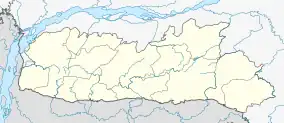| Nokrek National Park | |
|---|---|
| Nokrek Biosphere Reserve | |
 | |
  | |
| Location | West Garo Hills district, Meghalaya, India |
| Nearest city | Williamnagar, Tura |
| Coordinates | 25°32′N 90°7′E / 25.533°N 90.117°E |
| Area | 47.48 km2 (18.33 sq mi) |
| Established | 1986 |
| www | |
The Nokrek National Park,[1] the core area of the Nokrek Biosphere Reserve, is a National park located approximately 2 km away from Tura Peak in West Garo Hills district of Meghalaya, India.The Nokrek Biosphere Reserve along with the Nokrek National Park was added by UNESCO to its list of Biosphere Reserves in May 2009.[2][3] along with the Balpakram National Park in South Garo Hills. The Nokrek area is a hotspot of biodiversity in Meghalaya.[4] Established in 1986, the National Park area comprising around 47.48 square kilometres is looked after by the Northern Nokrek Range and the Southern Nokrek Range under the East & West Garo Hills Wildlife Division of the Meghalaya State Forest Department under the administrative control of the Government of Meghalaya, India.
The Nokrek National Park is located in the middle of the West , East and North Garo Hills Districts.
Administration [5][6][7]
The Nokrek National Park area is looked after by a State Forest Department Officer of the Rank of Divisional Forest Officer / Deputy Conservator of Forest headquartered in Tura , West Garo Hills , Meghalaya . He/she is assisted by three Forest Range Officers looking after the Northern, Eastern and Southern aspects of the National Park. However the control of the buffer and Transition zones of the Nokrek National Park ie the area outside the National Park measuring around 772.52 Square kilometers vests solely with the community / land owner concerned and the State Forest Department has little or no say over what is implemented in the areas outside the Core Area.
Pending the final notification of the Eco Sensitive Zone of the Nokrek National Park, a default radius of 10 Km from the National Park Boundaries has been declared as Ecosensitive Zone by the Government of India which leads to prohibition of certain activities which may prove detrimental to the environment like quarrying of stones ,boulders , construction of buildings , restrictions on certain developmental activities , etc
Fauna and flora
The Nokrek region is believed to host a population of the red panda that has generated curiosity across the world, one of which was accidentally shot by Dr J. Lao in 1960s.[8][9] However apart from that lone sighting, there has never been any more sightings of the red panda in recent years and hence it is generally believed that that incident was from red pandas brought about by Nepali Porters wherein one animal had escaped and was accidentally shot by Dr LJ.Lao. The Nokrek area is also an important habitat of the Asian elephant.[10] The park had eight species of cats, ranging from the Royal Bengal tiger to marbled cat, but the current status of the first is uncertain.[11]
There are seven species of primates in Nokrek. The rare stump-tailed macaque is frequently seen near the main trek to the peak.[12] The pig-tailed macaque also occurs.[13] The Western Hoolock gibbon are common and their calls can be heard all over the Nokrek area.[14] The Gaur, common leopard, Chinese pangolin, Ferret Badger, Asiatic Elephant has also been recorded in Camera Traps laid by the State Forest Department. A variety of Snakes have also been recorded in the area, prominent observed and recorded species being the Burmese Python, King Cobra, Spectacled Cobra, vine snake, ornate flying snake, Banded Krait, striped Keelback, red necked keelback Bronzeback species, Viper species,
The Nokrek region is also an Important Bird Area.[15][16]
There is a vast range of plants found in the park. A huge canopy of thick, tall, and lush green forests covers Nokrek and its environment. The mother germplasm of Citrus indica (locally known as Memang Narang) has been discovered by science researchers within the Nokrek Range area. This discovery led to the establishment of the National Citrus Gene Sanctuary-cum-Biosphere Reserve covering an area of forty-seven square kilometres. The area has wild varieties of citrus fruits that provide a gene pool for commercially produced citrus. Big monkeys are also found in the villages :3
Geography
The entire Biosphere Reserve is hilly. The rock is mainly gneisses, granulites, migmatites, amphibolites and banded iron formation, intruded by basis and ultra-basic bodies. In most of the Biosphere Reserve area, the soil is red loam. But sometimes it varies from clayey to sandy loam. The soils in the Biosphere Reserve are rich in organic matter and nitrogen, but deficient in phosphate and potash. The area consists of patchy sedimentary rock composed of pebble bed, sandstone, and carbonaceous shales.
All important rivers and streams of the Garo Hills region rise from the Nokrek Range, of which the river Simsang, known as Someshwari when it emerges into Bangladesh at Baghmara, is the most prominent.
Notable sites
Notable sites in the park include the Nokrek Peak, Nokrek A'pal and the Matcha Nokpante ( meeting places of tiger). Chandigre Rural Tourism Resort is 9 Kms away from Nokrek Gate. Several waterfalls like Wachi Dare and Simsang Dare is located near the Nokrek National Park. The Daribokgre village is the last village on the way to the Northern aspect of the Nokrek National Park and it is the Base Camp for many travelers, Researchers and Tourists. On the less travelled and unfrequented southern side , the picturesque villages of Anchigre and Dana Adugre are the last villages enroute to the Southern Aspect of the Nokrek National Park . The southern aspect of the Park can be also be accessed from the adjoining Tura Peak Reserved Forest .
Tourist Lodges & Homestays
Entry into the Nokrek National Park is regulated by the State Forest Department . Entry permits to the Park are available on payment as per rates fixed by the Chief Wildlife Warden cum Principal Chief Conservator of Forest (Wildlife) , Meghalaya .The entire stretch is a No-Plastic Zone and travellers are advised not to carry single use plastic items like disposable water bottles, etc into the Park. Entry into Daribokgre is regulated by the local community .
Accommodation to the Northern Aspect of the National Park is available at the following home stays and guest houses :
1. Balkasin Homestay / Bambitpa's Homestay 2. A'chik Heritage Pursuit's Cottage 3. Daribokgre Nokachik 4. Daribokgre Helipad Campsite 4. Sakal Aduma Nokachik and others .
Accommodation in the Wildlife Inspection Bungalow maintained by the State Forest Department is also available on request. The Divisional Forest Officer, East & West Garo Hills Wildlife Division , Tura is to be contacted in this regard .
See also
References
- ↑ Management Plan of Nokrek National Park. Tura: Forest& Environment Department , Government of Meghalaya. 2017–21.
- ↑ "Three Indian sites added to UNESCO list of biosphere reserves". Sify. 27 May 2009. Archived from the original on 28 October 2014. Retrieved 30 May 2009.
- ↑ "UNESCO Designates 22 New Biosphere Reserves". Environment News Service. 27 May 2009. Retrieved 30 May 2009.
- ↑ Choudhury, A.U. (2003). Meghalaya's vanishing wilderness. Sanctuary Asia 23(5): 30-35.
- ↑ "Protected Areas | Official website of Meghalaya Biodiversity Board,Government of Meghalaya, India". megbiodiversity.nic.in. Retrieved 13 July 2023.
- ↑ "Biosphere Reserves". wii.gov.in. Retrieved 13 July 2023.
- ↑ https://plus.google.com/+UNESCO (22 January 2019). "Nokrek Biosphere Reserve, India". UNESCO. Retrieved 13 July 2023.
{{cite web}}:|last=has generic name (help); External link in|last= - ↑ Choudhury, A.U. (1996). Red panda in Garo Hills. Environ IV(I): 21.
- ↑ Choudhury, A.U. (2001). An overview of the status and conservation of the red panda Ailurus fulgens in India, with reference to its global status. Oryx 35(3):250-259.
- ↑ Choudhury, A.U. (1999). Status and conservation of the Asian elephant Elephas maximus in north-eastern India. Mammal Review 29(3): 141-173.
- ↑ Choudhury, A.U. (2003). The cats in North East India. Cat News 39:15-19.
- ↑ Choudhury, A.U. (2002). Status and conservation of the stump-tailed macaque Macaca arctoides in India. Primate Report. 63: 63-72.
- ↑ Choudhury, A.U. (2003). The pig-tailed macaque Macaca nemestrina in India - status and conservation. Primate Conservation 19:91-94.
- ↑ Choudhury, A.U. (2006). The distribution and status of hoolock gibbon, Hoolock hoolock, in Manipur, Meghalaya, Mizoram, and Nagaland in Northeast India. Primate Conservation 20: 79-87.
- ↑ Islam, Z. & Rahmani, A. (2004). IBAs in India. BNHS & BirdLife Int., Mumbai & Cambridge
- ↑ Choudhury, A.U. (2010). Nokrek national park – an IBA in Meghalaya. Mistnet 11 (1): 7-8.
Further reading
- Management Action Plan of Nokrek National Park for 2012-13 to 2016-17 published by the Divisional Forest Officer, East & West Garo Hills Wildlife Division, Tura
External links
- "Protected Area Gazette Notification Database (Meghalaya)"(registration required)
- (registration required)
- WebIndia123 - National parks of Meghalaya